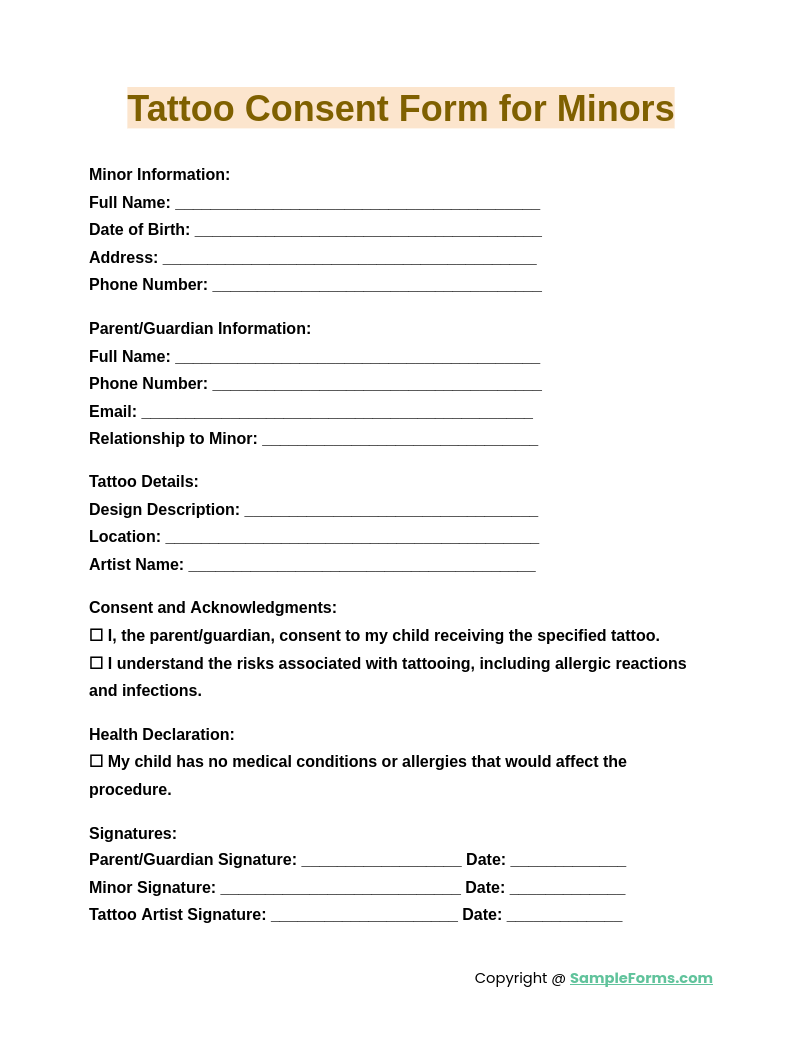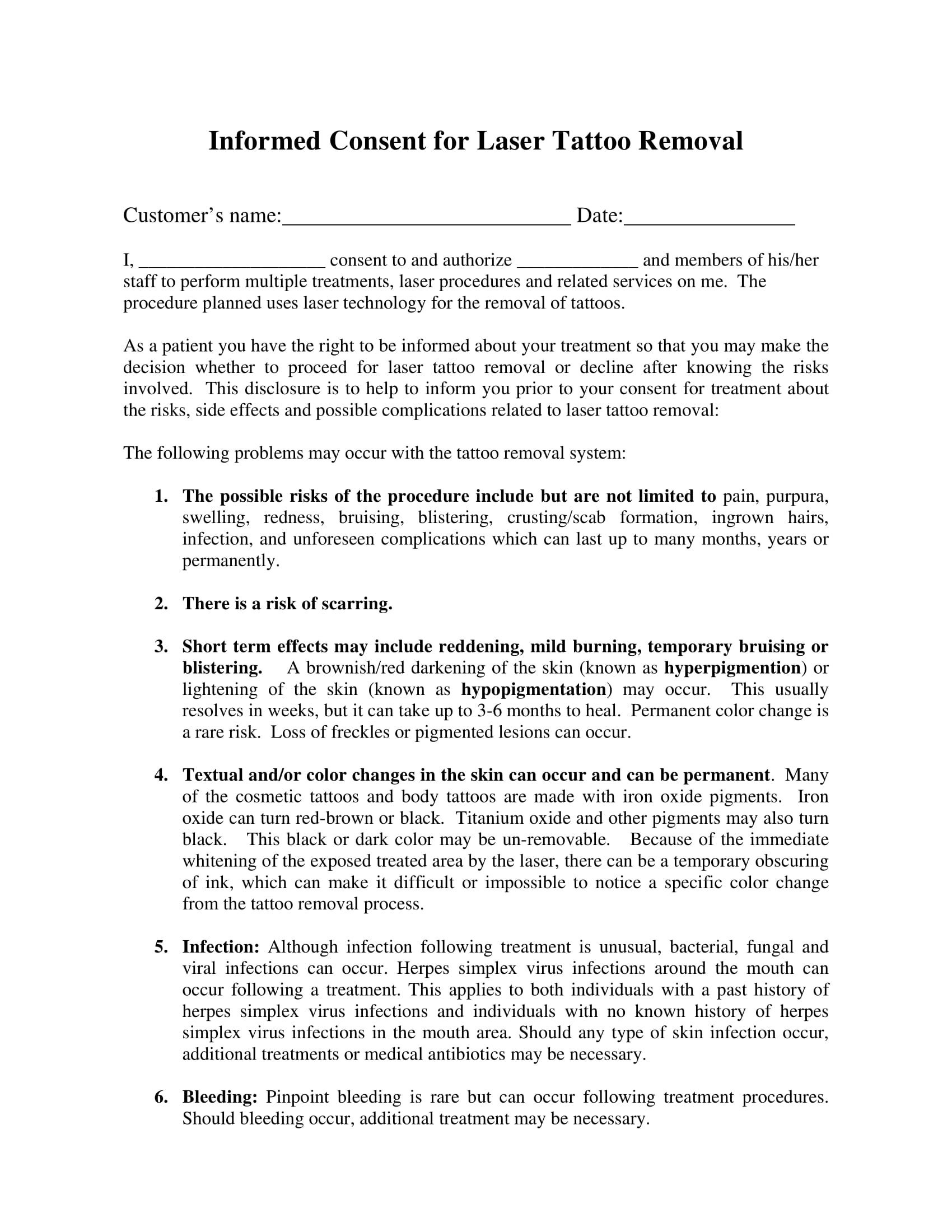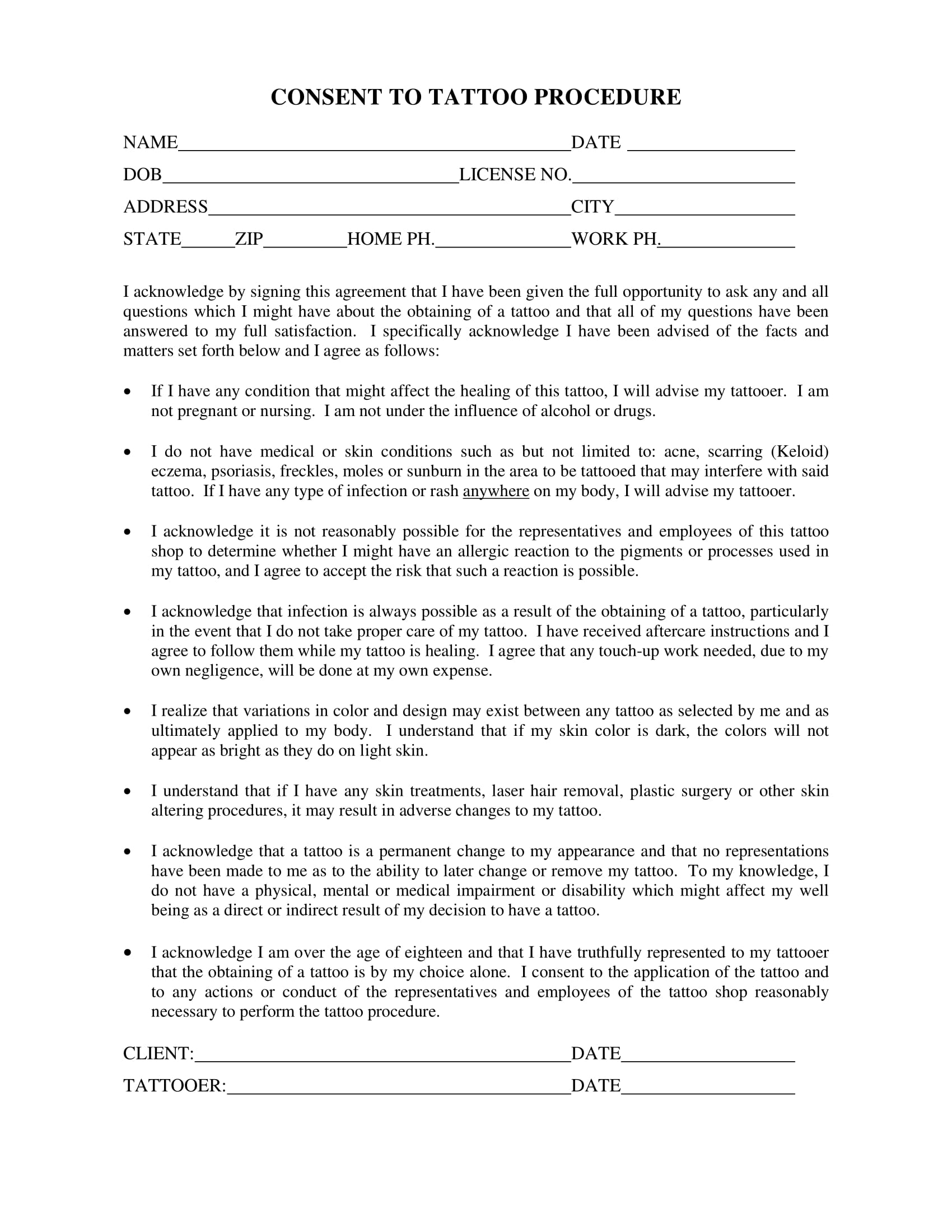A Tattoo Consent Form is a vital document that ensures both the client and the tattoo artist are fully informed about the procedure. This form, along with a Tattoo Release Form, outlines the risks, medical conditions, and consent to proceed with the tattoo. It’s a key legal safeguard for both parties. By completing this form, clients acknowledge understanding the process, potential aftercare, and any health risks associated with the procedure. The form typically includes personal details, medical history, and preferences regarding the tattoo. This process helps maintain a professional, safe environment for everyone involved.
Download Tattoo Consent Form Bundle
What is Tattoo Consent Form?
A Tattoo Consent Form is a document used to gain informed consent from the client before performing a tattoo. It provides details about the procedure, health risks, and aftercare instructions. This ensures that the client is fully aware of the process and any potential complications, allowing for a safe and professional tattooing experience.
Tattoo Consent Format
Client Information:
Name: ____________________________
Age Verification: ____________________________
Contact Details: ____________________________
Tattoo Design Details:
Description: ____________________________
Size: ____________________________
Placement: ____________________________
Health Declaration:
Current Health Condition: ____________________________
Contraindications (if any): ____________________________
Risk Acknowledgment:
Risks Explained: ____________________________
Aftercare Instructions: ____________________________
Parental Consent (if applicable):
Parent/Guardian Name: ____________________________
Signature: ____________________________
Artist Confirmation:
Hygiene Compliance: ____________________________
Design Compliance: ____________________________
Client Signature:
Acknowledgment of Risks: ____________________________
Date: ____________________________
Tattoo Release Consent Form

A Tattoo Release Consent Form grants permission for tattoo procedures, acknowledging risks involved. Clients agree to the terms, ensuring safety during the process. It ensures protection for both the client and the tattoo artist. Similar to a Field Trip Consent Form, it serves as a legal document to protect involved parties.
Tattoo and Body Piercing Consent Form

The Tattoo and Body Piercing Consent Form ensures clients are informed about the risks of both tattoos and piercings. Clients must acknowledge these risks and sign the form before any procedures begin, similar to an Informed Consent Form in medical settings.
Temporary Tattoo Consent Form

A Temporary Tattoo Consent Form is designed for clients opting for temporary tattoos. This form includes health information and precautions, protecting both the client and the artist. It’s somewhat similar to a Photo Consent Form, ensuring clients are informed about the temporary nature of the tattoo.
Tattoo Consent Form for Minors

A Tattoo Consent Form for Minors requires parental consent for minors receiving tattoos. This form ensures parents are aware of potential risks and complications, mirroring the approach of a Minor Travel Consent Form where parental approval is necessary for legal purposes.
Browse More Tattoo Consent Forms
Tattoo Consent Form Sample
Eyebrow Embroidery Tattoo Consent Release Agreement Form
Laser Tattoo Removal Informed Consent Form
Notarized Minor Child Tattoo Consent Form
Permanent Tattoo Client Consent Form
Tattoo Procedure Consent Form
Tattooing Consent Form Sample
What should be on a tattoo consent form?
A tattoo consent form ensures clients understand the procedure and risks. Key elements include:
- Personal Information: Name, age, and medical history of the client.
- Acknowledgment of Risks: Clients must agree to potential risks.
- Tattoo Description: Design and location details.
- Artist Responsibility: Agreement on the tattoo artist’s role.
- Signatures: Consent from the client, and sometimes witnesses. This form is essential for both the client and tattoo artist to ensure understanding, much like a Travel Consent Form for trips.
How do you get a notarized consent form?
Getting a notarized consent form involves steps to verify signatures. Here’s the process:
- Prepare the Form: Fill out the necessary information on the form.
- Find a Notary: Look for a licensed notary public.
- Present Identification: Show valid ID to confirm your identity.
- Sign in Front of the Notary: Only sign when the notary is present.
- Notary’s Seal: The notary adds their official stamp and signs the form. This ensures legality, similar to an Invisalign Informed Consent Form for dental procedures.
What proof do you need to get a tattoo?
To get a tattoo, certain proof is required to ensure safety and legal compliance. Key documents include:
- Proof of Age: A government-issued ID is needed.
- Medical History: Any allergies or health conditions must be disclosed.
- Parental Consent: Minors require a signed consent form from a guardian.
- Health Status: You may need to confirm you’re free from infections.
- Tattoo Design Approval: The design and placement must be confirmed. This process is essential, similar to a Vaccine Consent Form for vaccination.
What should be included in a tattoo portfolio?
A tattoo portfolio is essential for showcasing the artist’s skills. Key elements to include are:
- High-Quality Photos: Clear images of previous tattoos.
- Tattoo Styles: Examples of different styles the artist specializes in.
- Client Testimonials: Positive feedback from past clients.
- Artistic Skills: Drawings and sketches to show design talent.
- Aftercare Tips: Information on proper tattoo care post-session. Just like a Video Consent Form, it’s essential for clarity in agreements and permissions.
What do tattoo artists refuse to do?
Tattoo artists have specific practices they will not perform. These include:
- Offensive Designs: Any harmful or inappropriate symbols.
- Unrealistic Expectations: Designs that don’t match the artist’s style.
- Tattooing Minors Without Consent: Legal restrictions apply to underage clients.
- Unhygienic Practices: Artists refuse clients who refuse proper hygiene.
- Excessive Tattooing: Some refuse extensive sessions that may be harmful. Similar to a Check Consent Form, understanding restrictions helps ensure safety and clarity.
How long to keep tattoo consent forms?
Tattoo consent forms should be kept for at least 2-5 years for legal and liability purposes, similar to a Client Consent Form in medical or therapy settings.
What should be written in a consent form?
A consent form should include client information, risks, tattoo details, and acknowledgment of the procedure. This ensures transparency, just like a Health Consent Form for medical procedures.
What states allow tattoos at 16?
States like California and Colorado allow 16-year-olds to get tattoos with parental consent. This varies by state, similar to a Survey Consent Form required for participants.
What states do not require a tattoo license?
Some states, like Georgia, do not require a tattoo license, but they still enforce health and safety standards, like an Emergency Consent Form for safety precautions.
Should I let my 16 year old get a tattoo?
Parents should carefully consider the decision and ensure their child understands the risks. Parental consent is necessary, similar to a Participant Consent Form in research.
Can I use my school ID to get a tattoo?
A school ID may not be valid for tattoo consent, as legal age verification is required. Some states accept Dermal Filler Consent Form to confirm age for cosmetic procedures.
Is it a felony to tattoo without a license?
Tattooing without a license is a felony in many states, leading to fines and legal trouble, similar to violating terms in a Therapy Consent Form for professional conduct.
Can you get a tattoo license online?
Tattoo licenses typically require in-person training and exams; they cannot be obtained fully online, similar to obtaining a Financial Consent Form for financial planning or agreements.
How do you get consent for a tattoo?
Consent for a tattoo involves a signed form acknowledging risks, design choices, and the tattoo artist’s responsibility. It’s similar to a Questionnaire Consent Form in other professions.
What do tattoo waivers say?
Tattoo waivers outline risks, responsibilities, and consent to undergo the tattoo procedure. This is essential for legal protection, much like an Model Consent Form for urgent medical situations.
In conclusion, the Tattoo Consent Form is a critical document for protecting both the client and the artist. By completing this form, clients acknowledge their understanding of the tattoo process, risks, and necessary aftercare. It ensures transparency, reduces liability, and fosters a professional environment. Similarly, a Travel Consent Form can protect creators and clients by securing consent for recording and sharing content.
Related Posts
-
FREE 7+ Drug-Alcohol Testing Consent Forms in PDF | MS Word
-
FREE 8+ Botox Consent Forms in PDF | MS Word
-
FREE 6+ Waxing Consent Forms in PDF | MS Word
-
Surgical Consent Form
-
Field Trip Consent Form
-
FREE 6+ Caregiver Consent Forms in PDF | MS Word
-
FREE 6+Sample Survey Consent Forms in MS Word | PDF
-
FREE 10+ Check Consent Forms in PDF | Ms Word
-
Parental Consent Form
-
FREE 6+ Model Consent Forms in MS Word | PDF
-
FREE 7+ Participant Consent Forms in MS Word | PDF
-
FREE 7+ Therapy Consent Forms in MS Word | PDF
-
12+ Photo Consent Form
-
FREE 11+ Media Consent Forms in PDF | Ms Word | Excel
-
FREE 22+ Medical Consent Forms in PDF | Ms Word











